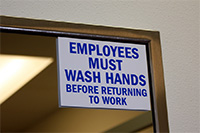Risk Based Systems in Packaging Manufacturing
By Neil Milvain
The British Retail Consortium (BRC) has recently released the latest edition of their Packaging Standard. This is a significant move towards standardizing the production of packaging materials, not just within the food industry but also in other sectors that were perhaps previously overlooked.
Does Quality Pose a Safety Risk?
One of the changes within the standard is to include quality within the risk assessment. This will no doubt pose some challenges to the way the hazard analysis is currently used. For example, in some circumstances, is quality more important than the potential food safety risk presented by the packaging material?
As risk assessment has now been covered under ISO 9001, clearly there is a move for risk assessment to be considered as a broader topic within any management system. For some time, Hazard Analysis Critical Control Point (HACCP) has served as the standard historical approach for packaging manufacturers, mostly at the demand of their customers. With a move towards encompassing quality attributes within the assessment, is HACCP really fit for purpose?
Considering a modified HACCP
One important element of a HACCP-based system is the Decision Tree, which is essentially the tool for establishing the Critical Control Points (CCPs) within a system. However, the traditional HACCP approach does not consider quality. It only covers physical, chemical and microbiological hazards that have an effect on food safety. Is it possible to embed quality into this model? Arguably, probably not, if the Codex approach is taken, which is specifically related to food safety.
So what needs to be considered is a modified HACCP. This would include all the components of the traditional approach but with some additional hazards included, impacting on the functionality of the packaging, rather than on the safety of the product contained within the packaging.
For Example:
Excessive flash on the thread area of a blown bottle
This in itself may have no overall effect on the safety of the beverage, but may present a safety risk to the consumer
Mixing of closures in a manufacturing plant
This is not likely to present a food safety risk. However it may pose an unacceptable quality defect at the bottling plant, leading to loss of production and downtime.
So how can the risk assessment be modified to ensure that all possible hazards are considered? In order to meet the requirements of ISO 22000, a HACCP-based model must be used. Simply changing to a more simplistic model is not necessarily workable.
If the risk assessment is modified in this way, is it appropriate to use the decision tree, which specifically relates to food safety hazards? The answer lies in considering what the decision tree is for. Through the assessment of the risk, it is possible to identify those that are not adequately controlled through the prerequisite program. By applying the decision tree, further evaluation can be made of the hazards posing the highest possible risk and therefore needing extra levels of control. Hence, it would be reasonable to continue the use of the decision tree but to modify the language used. For example, rather than CCPs, CQP (critical quality points) can be identified.
In principle, this could make the risk assessment a much longer and more unwieldy document. However, if there is a well-managed and controlled quality management system in place, these aspects could be covered through this activity. The quality aspects would then become part of the prerequisite programme without needing to be reconsidered within the HACCP.
This implies that the quality-related hazards would need to be clearly identified and shown to be controlled through the quality system.
If the examples above are reconsidered:
Excessive flash on the thread area of a blown bottle
The flash may develop over time and may not necessarily be straightforward to detect. Over time, the sampling frequency may need to be increased to ensure that the issue can be detected
Mixing of closures in a manufacturing plant
The rogue closure may be present as a result of poor line clearance, so it may be necessary to consider increasing inspections following a design change, or including a vision system specifically to detect a rogue closure.
A broader approach to HACCP
Due to poor implementation or understanding of HACCP within the packaging industry, packaging companies may wrongly identify a number of CCPs which are not food safety issues. Including quality and functionality in the risk assessment can help the business focus its attention on those areas that are significant.
In conclusion, adopting a broader approach to risk assessment makes it possible to not only demonstrate that you are managing your food safety risk but also dealing with more significant and potential risks to brand and quality.
About the Author
Neil Milvain is Global Product Manager – Packaging for SGS and he is responsible for the company’s certification & business enhancement programs. He has global responsibility for all audit standards related to packaging and ancillary industries for SGS and he works with key global accounts to ensure the company provides the best possible service.
To have more articles like this emailed to your inbox, become a GFSR Member today!

-
 FeaturedRisk management
The Cost of a Breach: What a Cyberattack Could Mean for Food Safety Recalls
FeaturedRisk management
The Cost of a Breach: What a Cyberattack Could Mean for Food Safety Recalls
-
 FeaturedRisk management
Securing the Food Chain: How ISO/IEC 27001 Strengthens Cybersecurity
FeaturedRisk management
Securing the Food Chain: How ISO/IEC 27001 Strengthens Cybersecurity
-
 FeaturedRisk management
Revolutionizing Food Safety Training: Breaking Out of the “Check-the-Box” Mentality
FeaturedRisk management
Revolutionizing Food Safety Training: Breaking Out of the “Check-the-Box” Mentality
-
 GFSI Standards
GFSI 2025: Building Trust, Tech-Forward Solutions, and Global Unity in Food Safety
GFSI Standards
GFSI 2025: Building Trust, Tech-Forward Solutions, and Global Unity in Food Safety
-
 FeaturedFood Safety
Integrated Pest Management: Strategies to Protect Your Brand’s Reputation
FeaturedFood Safety
Integrated Pest Management: Strategies to Protect Your Brand’s Reputation
-
 FeaturedFood Safety Culture & Training
No Open Door Policy: Challenges That Impact Pest Control in Food Processing Plants
FeaturedFood Safety Culture & Training
No Open Door Policy: Challenges That Impact Pest Control in Food Processing Plants




